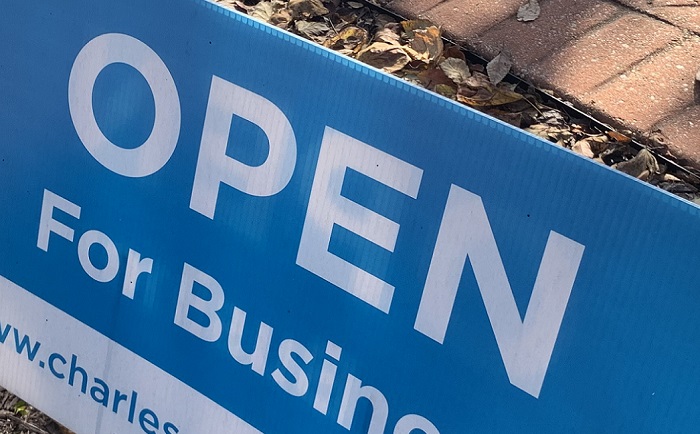With a shaky economy and uncertainty at the federal level, Tom Coale and Ryan Dressler argue that now is the time for the state to invest in a state-level New Markets Tax Credit program. (Photo by Angela Breck/Maryland Matters)
Maryland is a state with great economic opportunity, but it is not equally distributed. From Baltimore’s disinvested neighborhoods to Western Maryland’s struggling small towns and the Eastern Shore’s underdeveloped commercial corridors, too many communities lack the resources and capital needed for sustainable economic growth.
In the context of fiscal headwinds and uncertainty with the federal workforce, now is the time for the state to invest in a state-level New Markets Tax Credit (NMTC) program, modeled after the federal program. A $5 million annual investment each year for four years in the form of a tax credit (foregone tax revenue) — for a modest total of $20 million—would leverage significantly more private capital, spur job creation and provide a path forward for economic sustainability that is not dependent on federal spending.
The federal NMTC program was created in the year 2000 to encourage tens of billions of dollars of private investment in low-income communities. It provides tax credits to investors who fund projects in economically distressed areas, such as business expansions, mixed-use developments and community facilities. The program has a proven track record of attracting private investment, creating jobs and revitalizing neighborhoods, and is often the source of the first dollars invested in a redevelopment area.
Your opinion matters
Maryland Matters welcomes guest commentary submissions at [email protected].
We suggest a 750-word limit and reserve the right to edit or reject submissions. We do not accept columns that are endorsements of candidates, and no longer accept submissions from elected officials or political candidates.
Opinion pieces must be signed by at least one individual using their real name. We do not accept columns signed by an organization. Commentary writers must include a short bio and a photo for their bylines.
Views of writers are their own.
From 2003-2023, the federal NMTC financed 115 projects in Maryland, creating 15,200 permanent full-time equivalent jobs. But even with this notable impact, Maryland is far behind its peers in utilizing the program.
Through fiscal 2023, Maryland was ranked 19th among the states in NMTC allocation invested in projects located within the state at $1.3 billion, far below neighboring Pennsylvania, ranked ninth at $2.6 billion. Since 2007, 14 other states—including Ohio, Louisiana, Florida, Maine, Missouri, Illinois, and Nevada—have successfully implemented and renewed state NMTC programs. The federal program will award one of the largest amounts in program history in late 2025 – a full $10 billion of investment – but Maryland will need to develop a track record of success to compete.
Economic benefits of a Maryland NMTC program
-
Leveraging Private Investment: One of the most compelling reasons for Maryland to adopt a state NMTC program is its ability to attract private capital. Historically, every $1 of NMTC allocation generates $8 in private investment. This means that Maryland’s $5 million annual investment would yield $40 million of immediate program investment and encourage over $160 million of total private investment over the life of the program.
-
Revitalizing Maryland’s Most Distressed Communities: Many of Maryland’s struggling communities lack the infrastructure and commercial activity needed to drive economic growth. A state NMTC program would target investments in areas with high poverty rates, low median incomes and high unemployment, ensuring that resources reach those who need them most.
-
Baltimore City has numerous neighborhoods that would benefit from an infusion of investment to support small businesses, workforce development centers and community spaces.
-
Western Maryland, which has struggled with the decline of manufacturing and coal, could use NMTCs to fund tech hubs, tourism-related businesses and health care facilities.
-
The Eastern Shore, where agriculture and seafood industries remain dominant but undercapitalized, could see expanded processing facilities, cold storage infrastructure and commercial hubs.
These investments would not only stimulate business activity but also create jobs, improve property values, and enhance community services.
-
Job Creation and Workforce Development: The NMTC program has a strong track record of job creation. Projects funded by NMTCs often lead to construction jobs in the short term and permanent jobs in retail, manufacturing and services. For example, an investment in a new grocery store in a food desert would create construction jobs during development, retail jobs upon opening and supply chain jobs for distributors. A state-of-the-art vocational training center could train workers for high-demand industries such as health care, cybersecurity and clean energy, helping Marylanders gain skills and secure higher-paying jobs.
A Maryland NMTC could also be structured to small startups, and projects with strong community benefits, ensuring that economic growth is both inclusive and equitable.
Maryland has a choice: Continue relying solely on federal programs and risk losing out on critical investments, or take proactive steps to spur economic revitalization through a state New Markets Tax Credit program. Time is of the essence to position Maryland to fully participate in the large allocation of federal New Markets Tax Credit spending later this year.
Maryland has long been a state of innovation and economic opportunity. A state NMTC program would reaffirm that commitment, ensuring that every community — urban, rural, and suburban — has the resources it needs to thrive.
Read the full article here


